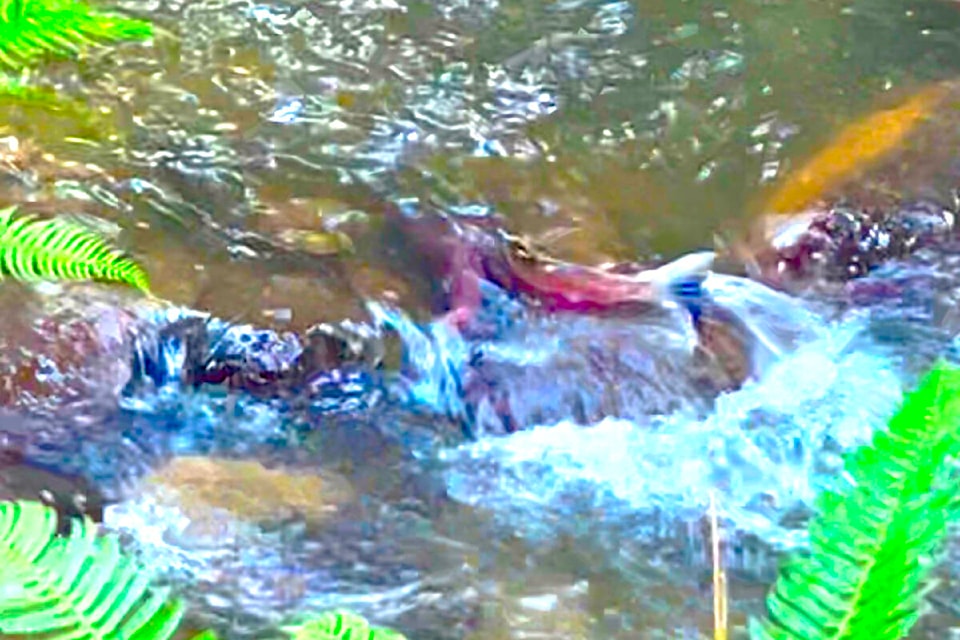Cougar Creek Streamkeepers were all smiles after tallying a record 328 wild coho salmon spawner returns to North Delta’s best salmon stream during the October-December 2023 spawning season.
Streamkeepers hastened to say they don’t claim direct credit for the 2023 boost in Cougar Creek’s spawner numbers; many other Lower Mainland creeks also saw strong coho returns.
Still, the volunteer group’s 40-year legacy of stewardship projects had no doubt laid a foundation for the creek’s self-sustaining run of wild coho – remarkable for such an urbanized setting.
“Our spawning weirs (low boulder dams) have been a hit with coho, who like to dig their redds (nests) and lay their eggs in the round gravel that accumulate behind each weir,” says Streamkeeper Deb Jones. “Volunteers added three new weirs in September as part of our annual hands-on workshop with BC Wildlife Federation. In December, some creekside walkers sent us video clips of spawners digging their redds at those new weirs. We’ve seen this happen with our other weirs before, but it’s so encouraging every time.”
“As for chum salmon – a species that should theoretically thrive in Cougar Creek’s conditions – spawner returns have disappointed despite major chum fry releases every spring. Those releases are great for getting kids and adults involved with salmon, but this hasn’t translated into a self-sustaining chum population.” Jones said.
“We’re trying a different tactic now,” says long-serving Streamkeeper Pete Willows, “with help from our DFO (Fisheries & Oceans Canada) Community Advisor. In addition to releasing chum fry raised elsewhere in a hatchery, we’re also planting chum eggs right into the bottom of the creek, in shallow redds that we dig ourselves, probably not as good as a salmon would.”
The hope is that any chum hatching these eggs will be imprinted on Cougar Creek from birth. When they return from their time in the ocean, they’ll be more likely to return here instead of to the creek where the hatchery is located. “We won’t know for a couple of years if this will work,” Willows says, “but it’s worth a try.”
Cougar Creek Streamkeepers continued with their stewardship projects, which occurred not only within and alongside Cougar Creek (think stream-side plantings, and invasive plant removal), but also throughout the entire watershed in the form of “rain gardens”. These collect rainwater runoff from pavements and roofs, filter out pollutants and litter, and absorb the water deep into the ground, which can then seep gradually into the creek.
“It’s not enough to have a pretty stream flowing through a pretty vegetation corridor,” said Jones.
“You also need the help of the entire watershed (the area that drains into Cougar Creek) to provide a steady underground seepage of cool, clean water into the creek. Storm sewers send too much dirty water when it rains and no water when it doesn’t.
Getting as much rainwater as possible into the ground is the key to creek & fish health.”
For groups and individuals interested in helping, they recommend visiting www.cougarcreekstreamkeepers.ca and subscribe to their email list, to receive notices of upcoming stewardship events and other creek news. Armchair streamkeepers who just want to keep up on creek news are welcome to subscribe too.
“Check out the tips for home and garden on our website,” added Jones. “For example, wash your car on the lawn or gravel shoulder, so soap suds don’t go down a street drain and into the creek. And please, dogs, we love you – but you can do a lot of unintended damage to a salmon stream. Keep yourselves and your humans out of the creek, especially from October to May when salmon eggs and newly hatched fry are easily destroyed.” the group said.
